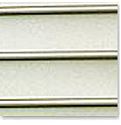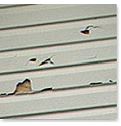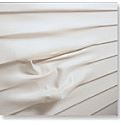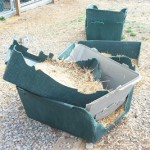Many of the homeowners we meet with are trying to decide between a few different types of siding, and vinyl is often one of them. A major concern that these homeowners have is how long the vinyl will last on their home. Well, the shelf life, so to speak, of vinyl siding depends on several factors, such as the grade, thickness, and quality of vinyl siding used; the climate you live in; the abuse it takes, and how well the siding was installed. The same vinyl that remains unscathed for 15 years on one house may only last 5 on another, depending on the following problem factors.
Color Fading
Vinyl sidings come with a variety of UV protection levels that protect it from the sun. Generally, thicker quality vinyl siding will last longer than the less expensive categories. Some owners report that vinyl siding can often start losing its color after about 5 years. After 15 years, it will show dullness and uneven colors. See our post on Can Vinyl Siding Be Painted? for information on the pitfalls of painting vinyl.
Deterioration from the Elements
San Antonio is not immune to severe weather, which can definitely leave its mark on vinyl siding. Hail will leave dimple marks, and wind can loosen rows. Vinyl siding is actually attached to the house in very few places, so severe winds have been known to blow it right off the house in some cases. Temperature changes will cause vinyl to warp and crack, and since San Antonio is famous for its hot summers, the heat can really bend vinyl siding out of shape over time. Working in tandem with the elements, trees and other vegetation planted too close to a house’s vinyl siding can cause damage like scratching and staining after just a couple of years. After 10-15 years, the cumulative effect of damage from normal weathering will be very apparent.
Man-made Damage
Remember that year Uncle Bob helped put up the Christmas lights and leaned the ladder against the siding and dented it? “Oops!” Then there was the time the kids decided to bounce their basketballs off of it near the driveway, or when you thought power washing it was a good idea and it started to come apart?
We have also seen from experience that putting your barbeque grill too close to your house when you have vinyl siding is an easy way to melt your house (not to mention releasing toxic fumes in the process). If the sprinkler system was installed to spray toward the siding instead of away from it, the water may leave stains and marks, and encourage the growth of mildew.
Certain brands of energy efficient double-pane windows catch the sunlight like a magnifying glass and reflect it away from the interior of the house. Sometimes these windows reflect right onto vinyl siding and end up melting it in just one season!
Destruction From Animals and Insects
“Help! My dog ate my siding!” This announcement isn’t as uncommon as you think. After all, many dog toys are made with vinyl, so it’s a familiar feel to sink their teeth into! Vinyl siding isn’t impervious to pet-related damage from pets who love to chew and scratch. The photo to the left shows what a dog is capable of doing to his own house, so just imagine him doing that to yours!
The good news is that termites, so frequently found chewing on houses in San Antonio, don’t eat vinyl. However, other insects may want to live in it if they can sneak inside. Bees and wasps especially love to find a way into the space between your siding and inner walls as joints loosen.
Can You Repair Vinyl Siding?
In many cases, damaged vinyl siding can be repaired rather than replaced entirely. The extent and severity of the damage will determine whether repair or replacement is necessary. Here are some common types of vinyl siding damage and whether they can be repaired:
- Cracks or splits: Small cracks or splits in vinyl siding can often be repaired using a vinyl siding repair kit, which includes a patch and adhesive designed specifically for vinyl siding. However, if the cracks or splits are extensive or affect the structural integrity of the siding, replacement may be necessary.
- Holes or punctures: Small holes or punctures can often be repaired using a vinyl siding repair kit. For larger holes or punctures, replacement may be necessary.
- Warping or buckling: If vinyl siding is warped or buckled, it may be a sign of underlying damage or moisture problems. In these cases, replacement may be necessary.
- Fading or discoloration: Fading or discoloration of vinyl siding is typically a cosmetic issue that can be addressed through cleaning or painting rather than replacement.
In general, it's best to consult with a professional siding contractor to assess the damage and determine the best course of action. They can advise you on whether repair or replacement is necessary and provide guidance on how to proceed. Keep in mind that repairing damaged vinyl siding can be more cost-effective than replacing it entirely, but it may not always be the best long-term solution depending on the severity and extent of the damage.
In closing
Again, all of these factors can vary greatly from house to house, but from our experience, most folks in San Antonio find that their vinyl siding lasts between 5 and 15 years before needing replacement. If you have any other questions about vinyl siding for your home or other siding options available, we’d be happy to help you any way we can. Feel free to contact us directly.






